If you are building a bathhouse, but the budget is limited, this is not at all a reason to refuse a rest room or a good dressing room. Even the most compact steam room, designed only for a steam room and a washing room, can have a bright and comfortable veranda. In it you can easily place a barbecue, a summer bedroom or a billiard room - whatever your heart desires! And now we will tell you more about the features of such construction and the internal layout.
So what is a veranda? In simple terms, this is the same terrace, only closed. Usually it has large window wounds on two or three sides, is insulated and is used even in winter. A veranda is usually built up to 6 m long and up to 4 m wide, but not more.
The veranda in its structure is quite similar to the terrace - it is attached to the bathhouse and has a roof, which is why both of these concepts are confused. But even the roof of the veranda is more thought out - rain should not fall inside such a room. And its shape also has its own characteristics:
- If the veranda is already built into the bathhouse at the construction stage, then the roof of both of them is the same.
- If you planned the veranda as a separate summer room, then it may have its own roof.
- The veranda is part of the bathhouse, not an attached building.
Traditionally, the veranda is attached to the longest wall of the bath or to the exit, but this is also not necessarily a rule. Moreover, the veranda does not have to be only square - this room can be made of any shape, even the most unimaginable.
In any case, the veranda is a wonderful temperature buffer for the bath, which protects vacationers from drafts and cold in winter, and from heat in summer. And in front of the veranda, they usually arrange a small courtyard garden, with fragrant bushes and fruit trees.
Is it open or closed? Even at the design stage, you will definitely have this question. So, an open veranda looks like the most ordinary fenced terrace, with which it is safely confused, and a closed one, which is already a multifunctional room. Warmth and comfort during any weather!
Construction features depending on the type of foundation
Architects always advise to build a veranda from the same material as the bathhouse itself. But in extreme cases, you can neatly attach a light wooden structure to the bath, no more. But to a wooden or frame bath you cannot attach a brick or timber veranda.
If you are just designing a veranda, then initially plan its location so that it is illuminated by the sun all day - this is important.
So, as with conventional construction, first determine the water table in your area and sketch out the project. Take into account the structure of the soil itself - if it is wrong to attach a veranda on heaving ground, after a few years it will crack in the walls and begin to float away from the house, like a chipped iceberg.
Option # 1 - on a strip foundation
The easiest option for a veranda is a strip foundation. It is good for stable soils with low water table levels, and even withstands fairly heavy walls. This is how it is built:
- We dig a trench of the required depth, leaving a width 10 cm greater than the future thickness of the walls.
- We do the simplest formwork, even from slate.
- If the walls of the veranda are made of brick or stone, we lay a reinforcing frame.
- Pour concrete mixture into the foundation.
- We wait until it dries completely and build the walls of the veranda.
Advice: avoid too complicated binding of the veranda to the bath - if one of them shrinks, then the risk of cracks is great.
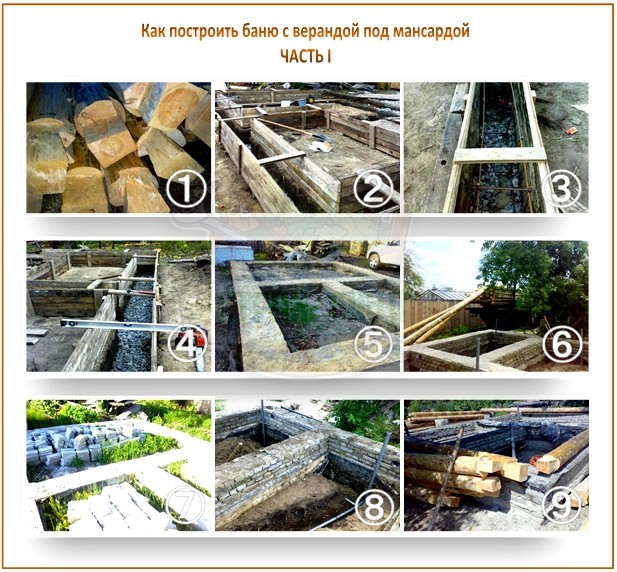

Of course there are strip foundation and cons: this is the laboriousness of the work and the considerable costs of the construction itself.
Option # 2 - on a columnar foundation
This foundation will take you much less time and money. Here you just need to dig pits along the axes of the future veranda and install posts made of stone, concrete or brick in them. But it is necessary to protect them from moisture: saturate the lower part of the posts with bitumen mastic.
If due to inexperience you cannot put all the columns according to the level, put plywood impregnated with aquatext on the necessary ones. But, if there are other points of maximum load under the veranda (for example, under a heavy brick barbecue), place the posts under them.
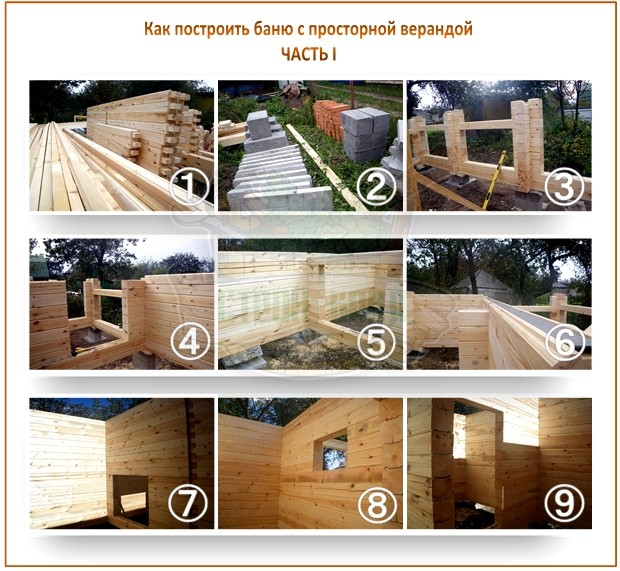

Between the posts, you can also install a grillage made of wood or metal, and if necessary, even arrange a tape columnar foundation.
Option # 3 - on a pile foundation
If the soil under the bath is problematic, then it is better to organize under the attached veranda pile foundation... Rather, its simplified version - bored piles... Here's how to do it:
- Drill hand tool wells at the right points. It is important that the depth just reaches stable soil layers and exceeds the level of groundwater.
- Use a roofing felt sleeve as waterproofing - just lower it directly into the well, and reinforce it if necessary.
- Pour concrete and connect the piles with a grillage.
Option # 4 - on a pile-screw foundation
This foundation for the veranda is good because it can be easily installed even in winter. These are simple metal pipes with blades on the tips. They do not need to be driven into the ground - you just need to screw them in by hand. But, if you do these with your own hands, then cover them with a special anti-corrosion paint.
For general aesthetics, you can use the same roofing material as for the entire bath, but about heavy ceramic tiles better to forget.
Be sure to lay boards with a deformation gap on the veranda floor. This is necessary so that the wood can then easily expand or contract - after all, the cold will just walk on the floor of this extension. Treat them with an antiseptic and paint. Even better - get a ready-made decking, where all these procedures have already been carried out in the factory under the supervision of specialists.
And finally, the last question: how to sheathe? The most convenient thing is the usual wooden clapboard - and beautiful, and inexpensive, and practical. It is not difficult: thanks to the extensive glazing, it does not have many "blind" areas. It is enough just to insert a heater into the resulting frame of the frame and close it with a sheathing.
How to attach a veranda to a finished bath
Often, a veranda is attached in order to make the bath more compact and energy efficient. This often happens when the steam room itself is being built in an unusual or simply ill-conceived architectural form - with extra corners, walls and bay windows. Then in the right niche sometimes it is better to arrange a small veranda, which again will serve as a necessary heat buffer and a useful area for the same winter garden, swimming pool or tennis court.
Of course, completing the veranda to the bathhouse is already more difficult than planning its construction even at the construction stage. And the difficulty here is this: already literally two meters from the walls of the bath, the soil may already be completely different, it happens. And this is fraught with the problem of joining the veranda with the building, and cracks in its foundation. That is why, even if you have already professionally examined the soil on the site and right at the place of the bath, you still carry out additional exploration of the soil specifically under the future veranda.
The second thing to do is draw up a project. More details can be found on our website using the internal search function. And already with a clear vision of what you want, you can further follow these steps:
- Step 1. Determine the angle of inclination of the roof. This is how you will accurately determine the difference between the levels of the front and back walls of the future veranda.
- Step 2. According to the outlined drawings, make wooden frame and support posts.
- Step 3. Place the pillars along the centerline of the roof and install the floor joists. Place them 60 cm apart using quality dry boards. For the manufacture of shed roof use two beams for verandas with dimensions of at least 10x50 cm - these are the so-called roll-over beams. So, attach one edge of the beam to the bath wall with anchors, and the other to the upper veranda trim. Next, place the rafters. Advice: it is advisable to place support posts between the rafters - this will give strength to the entire structure.
- Step 4. Lay insulation on the finished frame, and then overlap - the roof. Please note: the pitch of the rafter boards depends on the chosen one roofing material... For example, under a soft one, you definitely need to make a continuous flooring of boards. And the roof itself, whatever it is, should protrude at least 5 cm from the edge - so that rainwater does not destroy the roof in the first year.
- Step 5. Sheathe the rafters already inside the veranda with plywood or drywall.
- Step 6. Cover the sides of the roof outside with a "wooden apron".
- Step 7. Install windows.
- Step 8. We insulate the walls with the selected material.
- Step 9. We cover the floor with boards.
The most difficult thing at this stage is to correctly make the foundation. And here good news awaits you: the walls of the veranda are much lighter than the walls of the bathhouse, and therefore there is no need to organize a powerful and expensive foundation for such a building. But the savings should be in moderation, of course.
Of course, the most rational option is to lay the foundation for the veranda even at the stage of building a bath. Therefore, even if your budget has not yet been calculated for such an extension, but in the future there will be a veranda, still make a foundation for it. Just cover it with boards and protect it from moisture and dampness - you get a good temporary porch, where garden chairs can be placed in summer.
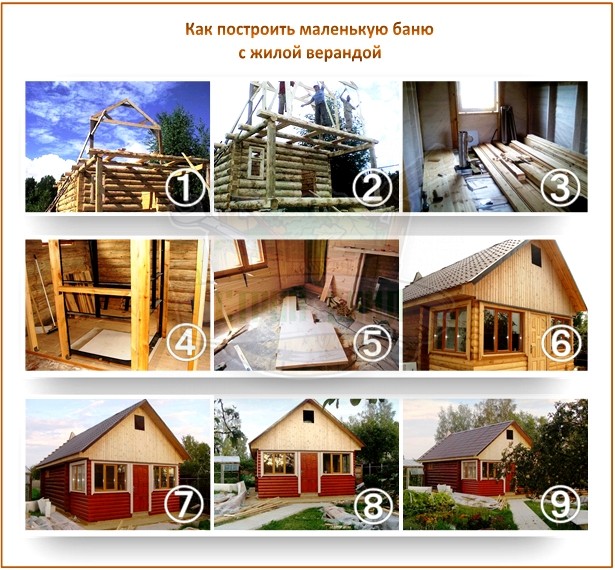
And this shrinkage can also be different: all due to the fact that the bathhouse and the veranda have different weights. And keep in mind that there is a danger here: adding a new foundation to an old one can in rare cases even destroy the bathhouse itself. And, especially on heaving soils, it is better not to connect such bases with each other in any way.
If you attach the veranda not to front door, and to the window, special serious work and there will be no radical change in the design of the bath. You just have to redo the window itself, turning it into a wide sliding door. And so that such a door does not become a cold bridge in the Russian frost, provide it with originally modern heat-insulating glass and special sealing profiles.
Veranda design: from classic to modern
But, if the veranda is being built of an open type, then the railings in it should not look like a small fence, which is sometimes built for the terrace - this is what these two types differ. The railings should be visible here, usually decorated with beautiful carvings and hanging flower pots. Pillars are also often made curly.
If you want to make the sauna veranda as bright and beautiful as possible, use transparent polycarbonate sheets instead of a regular roof. After all, greenhouses with such a coating, despite its visual fragility, withstand hail and tons of snow crushing for months. A veranda with a weightless top turns out to be stylish and sunny.
Also today, verandas with solid glazing are especially in vogue. This is a real winter garden, in which today they leave less and less space for plants, saving it for a billiard table, armchairs and even a samovar. But be careful: often for veranda glazing construction firms they offer to purchase light and inexpensive profiles from them so that there is more light. But, if you also visit the bathhouse in winter, and tea drinking is planned on the veranda, then it should be warm. Therefore, choose high-quality fittings and profiles for this.
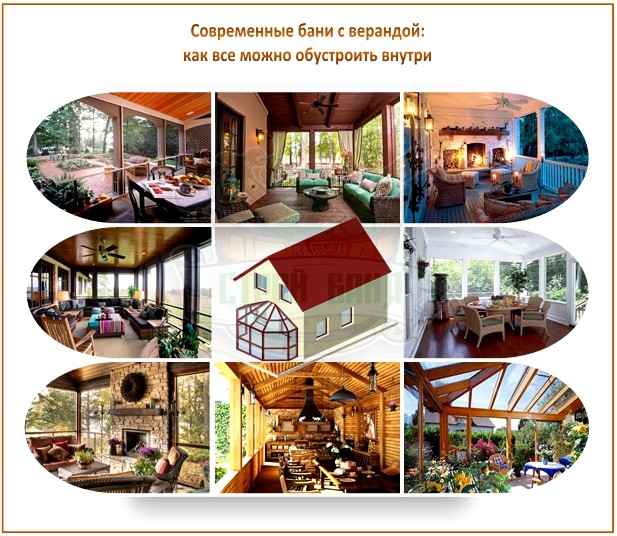
The most traditional solution for a closed sauna veranda is the tea area. But it just can be not only in the classical style - today there are many interesting options, ranging from beautiful oriental services, and ending with a dozen outlandish types of tea from different parts of the world.
When setting up a barbecue on the veranda, all safety rules and regulations are the same as for sauna stove - be careful! So, in the floor, a base for the stove is mandatory, and all walls must be protected in accordance with SNiPs. Make a hole in the roof for the barbecue chimney even at the clapboarding stage.
You can also arrange a green area on the veranda by hanging flower pots or placing large outdoor flowerpots that do not require frequent watering. But such solid extensions as a brick or stone veranda can easily be converted into living quarters in the future. Here you can organize a kitchen for summer holidays, hide a couple of folding beds and even purchase a mini-bar. A useful structure!
A terrace is a decking area that is built on a prepared base. There are a lot of types and varieties of this architectural addition:
- It can be located near the house, or it can be completely unrelated to it, or connected by a path.
- Maybe without a roof - then they say that it is open. Or covered with a roof.
- May or may not have walls. Walls can be solid or fenced.
- There are single or multi-level.
There are a lot of types of terraces: both in shape, and in the number of levels, and in materials
If we talk about the terraces that are adjacent to the house, then they are lateral and frontal, they can cover one, two, three or four sides. Sometimes they have an irregular shape. They can be under the same roof as the main building or have their own.
If we take into account that the most different materials can be used in the manufacture, then it is clear that the variations are simply innumerable.
- 1 Projects of baths from a bar with a terrace
- 1.1 Bathhouse 4 x 4.5 with a terrace
- 1.2 Project of a bathhouse 4 by 6 with a terrace
- 1.3 Drawing of a bath 6 by 5 (with a protruding terrace)
- 1.4 Project of a bathhouse 6 by 6 with an open terrace
- 2 What materials are they built from?
- 3 How to make a wooden deck on a pile foundation
- 3.1 Preparing the piles
- 3.1.1 Roofing material piles
- 3.1.2 Brick posts
- 3.2 How to make the bottom harness
- 3.3 Flooring
- 3.1 Preparing the piles
- 4 Terrace of tiles
- 4.1 Simple option
It is not so difficult to build a terrace in front of the bathhouse or next to it. In general, most often difficulties are caused by the lack of a project. If funds permit, it is better to order it, describing in detail what and how you imagine, what you want to achieve, and what things you absolutely do not like. If it is impossible to order the production of a personal project, there is an option to find one of the ready-made ones, slightly adjust it to suit your own needs. Here are several projects of baths with different terraces, which are easy to do with your own hands.
Bath 4 x 4.5 with a terrace
According to the project, the bathhouse consists of three rooms, a terrace is attached to it on a separate incoherent foundation (read about one of the options for its construction below). The bathhouse has three rooms:
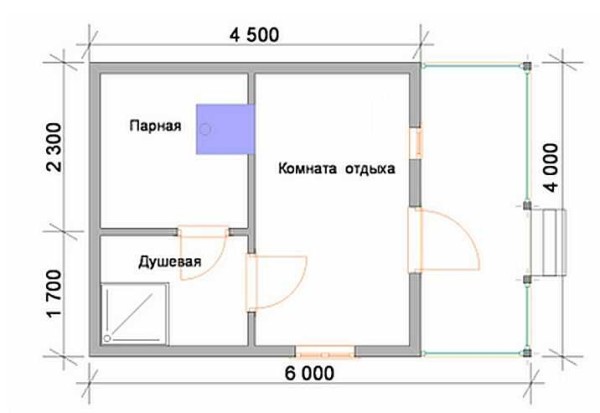
The parameters of the rooms can be changed by moving the partition that separates the rest room. If the bath is being built for a dry-air sauna, a large volume of the steam room is not needed: calculate the number of people who should fit in one go, then calculate the area of \u200b\u200bthe shelves for their comfortable arrangement: for "seating" places you can take 1-1.2 meters per person, "Recumbent" - 2.1-1.2 m. The width of the shelves - 0.7-0.9 m. Calculate the area of \u200b\u200bthe shelves, add space for the oven and its fence and a little area for free movement. Get the required area.
The calculation of the area of \u200b\u200bthe steam room in the Russian bath is similar, but if in the sauna "recumbent" places can be omitted - they usually only sit there, then in the Russian steam room they are mandatory. Another difference is that the fence of the sauna stove is wooden structurewhich prevents you from touching the hot walls. In a Russian steam room, if a metal stove is installed, then it must be covered with a brick screen, and these are completely different sizes. Therefore, the area needs to be allocated a large one.
Read more about the layout of the baths, the size of the premises here. About where and what windows to place is written in the article "Bath windows: where to install and what sizes". About what doors and their sizes are needed in the steam room and other rooms, read the article "Which doors to choose for a bath and sauna"
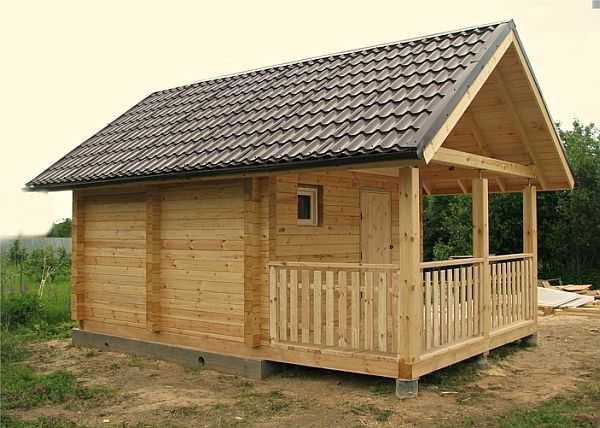
This is an example of what the implementation of the project looks like.
The use of such a bath in winter will not be comfortable: entering the recreation room directly from the street and the cold air will be a clear hindrance. To eliminate this drawback, you can either fence off part of the rest room under the vestibule, or make part of the veranda closed. The second option looks preferable due to the small size of the premises. But then you need to either make an entrance from the other side, or move the doors.
Optionally wood stove for a bath: for this project, you will need a compact version, perhaps high and narrow, but you can try to fit in just a small one. The volume will turn out to be very small, so small capacities should be enough. In this project, a stove is provided, which is heated from the rest room. At the same time, it will heat it too, so you need some power reserve, do not forget about this (if you plan to visit the bathhouse in winter). For example, Heat Malyutka, Varvara stoves - Palenitsa and Mini models, or Compact, Wasp, Shilka and Biryusa at Termofor.
Sauna project 4 by 6 with a terrace
This version of the layout of a small bath immediately provides for the allocation of a small vestibule, so this bath without alterations is suitable for winter use. Steam room and sink are separate, have almost the same dimensions, which is not always justified. If in the washing room they will only use a shower, then it can be made a little more compact by fencing off more space for a steam room (for a Russian bath). A shower can also be installed in the shower. If the height of the ceilings permits, it is mounted above the "gander" of the shower, if not - on the side.
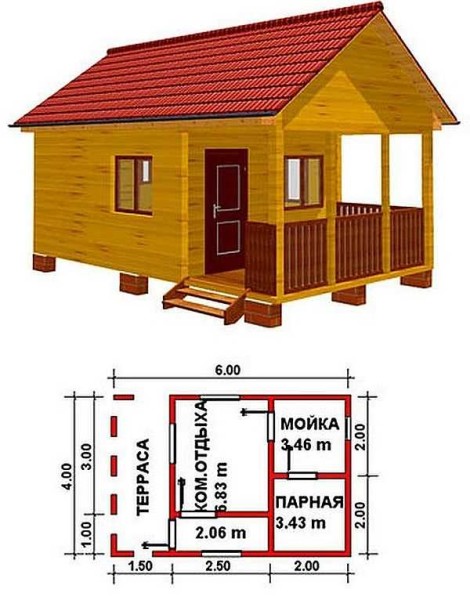
Sauna project 4 by 6 with a terrace
Bath drawing 6 by 5 (with a protruding terrace)
This project of a bath from a bar also has a fenced-in closed vestibule. It occupies a part of the terrace, but in order not to reduce its area, it was "pushed" beyond the building foundation. If you wish, you can further increase it by making it in the form of the letter "G". You will get a spacious playground for summer holidays. It will be possible to fence off a part for installing a barbecue on it (there are several projects here).
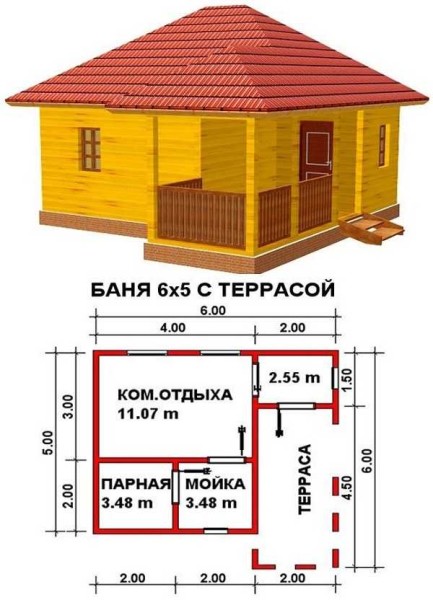
Sauna 4 to 5 with adjoining terrace
Baths project 6 by 6 with an open terrace
This layout option costs the same number of rooms. It's just that their area has become larger: now the dimensions allow. In this version, it is already possible to fence off a small room for a dressing room. And for winter use, you will need to organize a vestibule somewhere.
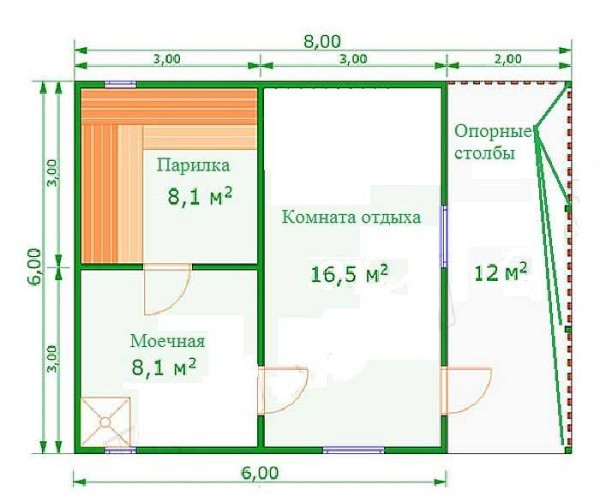
Baths project 6 by 6 with a terrace
If there is still an opportunity to add a little size, you can already "fit" the bathroom. It will turn out already guest house-bath, especially if you make a two-story bath. One of the options, however, on the same floor, is located in the photo below. More projects two-story baths can be found here.
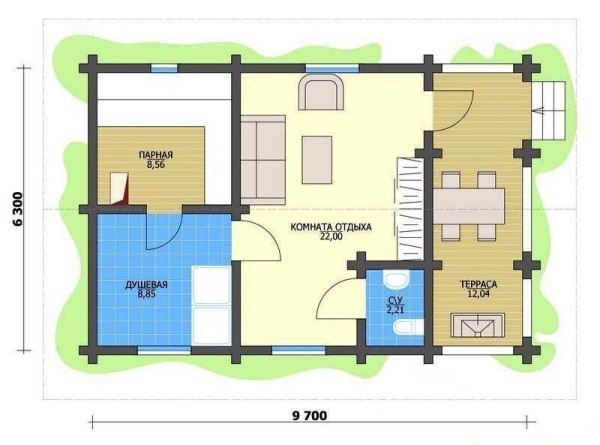
Large bath-guest house with a terrace
What materials are they built from?
To cover the terrace, you can use any construction material: wood, brick, building blocks, natural or artificial stone, paving, ceramic, ceramic granite tiles, natural or artificial stone, etc.
Despite the fact that wood on the street is not the easiest material to use, most often terraces are made of wood. In this case, use pine and spruce - have a constant headache: it needs to be serviced and repaired very often. The harder wood is more expensive, but it lasts longer and is less hassle.
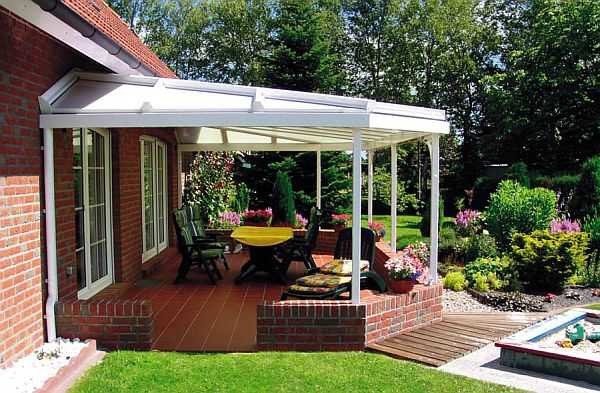
Near brick bath a terrace with a brick fence looks good
Near a brick bath, a terrace looks good, which also has a fence made of brick; in this case, it is rational to lay the terrace itself with tiles or stone. Much more practical option. True, for such sites it will be necessary to pour a slab of concrete.
If your soil is dry and not prone to heaving, it will be enough to make a dump of rubble and sand. It will be possible to lay paving slabs. It comes in different shapes and colors, so it can also look more than interesting.

A terrace with laid paving slabs looks very good. It can be combined with a blind area around the house. In this case, you will kill two birds with one stone.
How to make a wooden deck on a pile foundation
The most problematic option is wood. If you plan to use it, then you need to choose from varieties that tolerate being outdoors well. It is also necessary to treat it with protective impregnations, varnishing or staining.
Cooking piles
To create normal operating conditions for wooden terraces, it is necessary to think over the structure so that water does not accumulate under the structure. It is generally advisable to make a platform of wood raised above the ground level so that the boards from below are well blown and ventilated. Therefore, most often a pile or columnar foundation is made for such structures. Moreover, a fertile layer is removed under the terrace, the remaining soil is leveled and tamped, and then covered with rubble and also compacted. This is done so that the vegetation does not rot and does not spread "aromas" and spores.
The step of installing the posts is at least 1-1.5 meters - so the boards will not bend. Any material of manufacture. You can drive asbestos or iron pipes, pour concrete into them. This is a very durable but expensive option.
Roofing material piles
Much less money (but more labor) will require piles with roofing felt formwork.
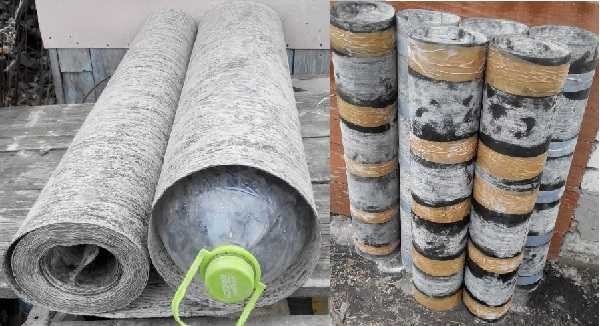
So you can make a permanent formwork for piles from roofing material
Roofing material is folded into round columns in two or three layers. Diameter - 20-22 cm, height - about 1 meter (70 cm drowned in the ground, 30 cm is on top). This is for soils with a medium tendency to heave. In order not to worry about measuring the diameter of this formwork, you can use a mold. If you find an eggplant from under the water of a suitable diameter (these are nine-liter containers), it will work simply: they screwed in roofing material, secured it with tape, took out the "mold" by the handle.
Fastening, as usual, is more convenient with tape. Only on the powder does he not want to stick. To ensure adhesion, we remove the crumb in the right places with a brush, wipe the cleaned area with white spirit. After drying, the hold is excellent. So prepare the required number of columns.
With the help of a drill, they make the required number of depressions a little larger in diameter than the molded posts and 25 cm deeper. These 25 cm go to the pillow device: they are covered with a 15 cm layer of rubble, rammed. Sand is poured, which is also rammed.
Then formwork is installed in the prepared pits. All columns must be level. This can be done with the help of two rods hammered along the edges of the planned terrace, and a cord stretched between them. Its verticality can be checked with a building level, if necessary, adjusting the height of the bars. The second way is to set the height of the rods using a hydro level (you can also use a laser one, but it's difficult to work with it outdoors - the beam is visible only in the evening or in cloudy weather). Having fiddled with the alignment of the cord, then quickly bring all the columns in one row to the same height. Repeat the procedure in the following.
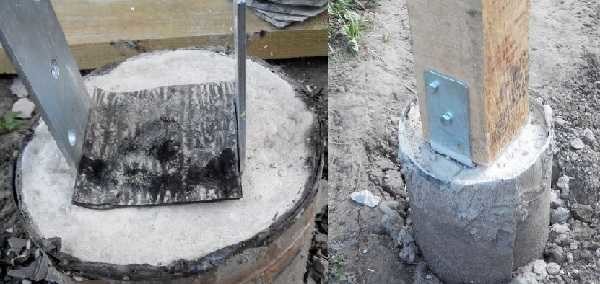
How to attach support posts to concrete piles is one option
You need to set the columns vertically. You can't do without a plumb line. A simple tool, but nothing better has been invented yet.
Further, to increase the strength, it is advisable to insert several reinforcement bars inside - 2-3 per one column. You can use smooth rods with a diameter of 8-10 mm. Then pour concrete inside. It needs to be compacted, since it is not worth knocking on the roofing material, you will need to take a long metal rod and bayonet (pierce through and pull a little from side to side). As a result of such actions, the concrete level will become slightly lower - air will come out, you will have to add a little. Everything becomes easier when you have a submersible hand or mobile concrete vibrator. When the solution sets, you can proceed to further work.
Brick posts
On heaving soils, the columns can simply be squeezed out, which is why the terrace will lead. A wider platform is needed here, which will stabilize the situation. For such a foundation, small pits are pulled out, measuring 50 * 50 or 60 * 60 cm.The soil is rammed in them, crushed stone is poured, it is also rammed, formwork is installed from boards 20-25 cm high.
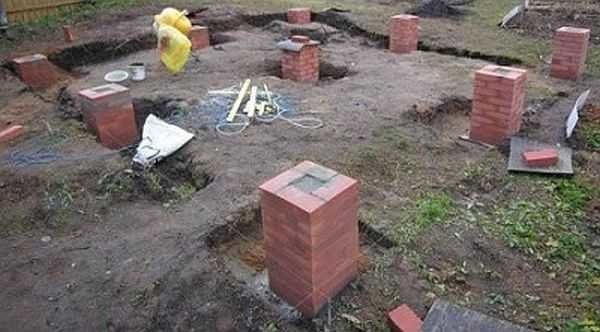
The foundation for the terrace can be made from brick posts
Several pieces of reinforcement are laid on the halves of the bricks - along and across - to get a cage (2-3 bars each). A pipe is inserted into the middle (verticality is checked). All this is poured with concrete (it is possible with gravel). Thickness - 20 cm.
After the mortar has set, a brick column is made around the pipe. The height is taken out just below the required flooring height - leaving room for the lower strapping.
How to make the bottom harness
There are two options for installing support posts:

The first method is used more often, but the second is also the case. It requires a little less cost, but there will be more fuss with laying the lags.
In the manufacture of the lower strapping, a beam of 100 * 75 mm, 75 * 75 mm or wider is used - it depends on the size of the terrace and the load on it. They are treated with antibacterial impregnations, laid on a concrete column covered with a layer of waterproofing (lay double-folded roofing material or smear with mastic, liquid waterproofing).
The beams are worth a lot, but you can cheat by making a spliced \u200b\u200bbeam from boards. It is not suitable for supporting pillars - the appearance is not the same, but for the lag it is even better, since it has increased strength. How to make a bar out of boards:
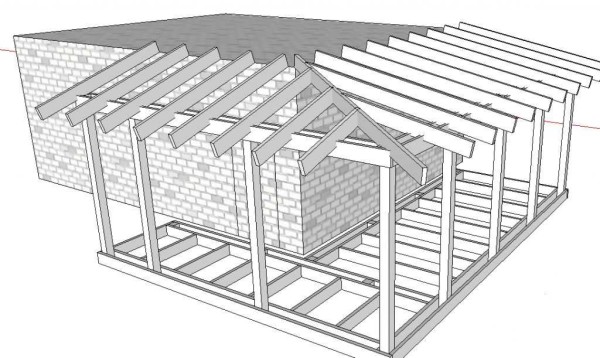
Regardless of the method chosen, all wooden elements must be impregnated with protective and antifungal compounds. To improve their appearance and extend their service life, they are varnished. It is better to use compositions for outdoor work, and if we talk about varnishes, then yacht is preferable - it is well adapted to a humid environment and protects the wood from the effects of salts.
The option of creating a metal frame is possible. You can use a powerful corner, a square pipe. This base is more reliable and durable. It is well primed, then painted thoroughly and will serve for decades. In order not to damage the board when it comes into contact with the metal, a waterproofing material is glued to the metal - such as "TechnoNIKOL", etc. When fixing the flooring, you will have to drill holes - it is unlikely that you will be able to screw the screws directly.
The frame can be welded from metal. Such a terrace will be much more maintainable.
Flooring
After making and fixing the strapping, you can start making the flooring. Edged boards are usually used. There is a special terrace board - it has not a flat, but a wavy front surface, but it is often laid around fonts or pools built into the terrace. A wavy surface, even in a wet state, does not allow sliding, and if you make a slight slope, then the water will drain quickly without lingering on the flooring.
The thickness of the board, as for the floor, is rarely thinner than 20 mm, although its thickness depends on the distance between the piles. With a distance of 1.5 meters, the thickness of the board is 25 mm, then it will not bend when walking.

Boardboards need a decent thickness. To make them last longer, they are treated with antispetic agents and varnished or painted
Tiled terrace
If you decide to make the site not from wood, but from tiles, you can go in several ways. It all depends on how you imagine your terrace.
If you are satisfied with paving slabs as a coating, the technology can be greatly simplified. The process is very similar to making a blind area around a house. The technology is similar, you can use the same techniques.
Simple option
The simplest, but very reliable and effective option is using profiled membranes and geotextiles. In this case, the soil is removed to the width of the future terrace, the depth is small - 20-25 cm is enough. If there is a roof on top, the platform can be made even; if a roof is not provided, a slope of 3-5 cm is formed for each meter (from the foundation).
If there is abundant precipitation in the region, groundwater is close, it is better to lay a drainage pipe along the edge of the terrace. This is a special corrugated pipe with holes. For it, they dig a small depression (about half the diameter), where they put it. The end of the drainage pipe is taken out into a drainage well or into a sewer system.
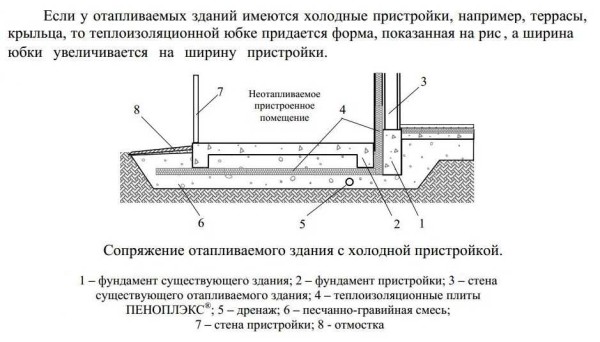
One of the options for arranging the terrace (with a drainage pipe under the tiles)
So that plants do not germinate under the coating, they are treated with special chemistry. After processing, the profiled membrane is spread over the entire width. If you will lay the drainage, then the edge of the membrane should go into the dug groove, reaching its opposite edge. A drainage pipe is placed on the membrane. Now all the moisture will roll down the film and get into it.
On the other hand, near the house, a 10-15 cm membrane is placed on the wall. They fix it there. A layer of geotextile is rolled out from above. He is also raised on the wall. Both films can be secured with a clamping bar. The second edge of the geotextile ends above the drain pipe (it is not fixed).
Now a layer of coarse and medium-sized crushed stone is poured. A curb is installed along the edge of the site (not above the drainage pipe, but closer to the house). Crushed stone is well rammed (preferably with a vibrating plate, but do not ram with a plate over the pipe). A layer of sand is poured on top, it is leveled, spilled with water and rammed. You can already lay tiles on it.
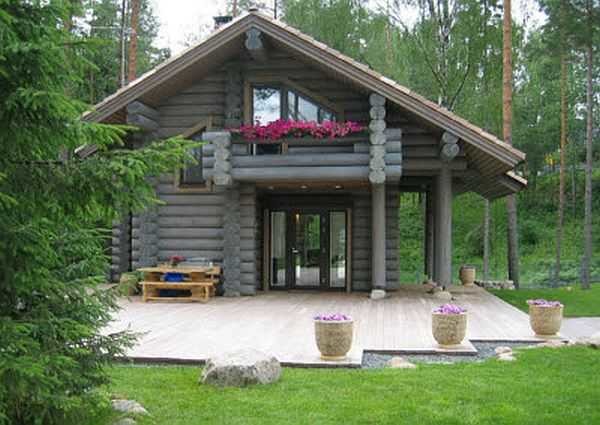
How such a terrace might look
The thickness of the layers is 10-15 cm. The depth of the pit for the terrace is selected so that the tiles are laid at the required height. It is difficult to say for sure, since the tiles can be of different thicknesses. Based on the purchased coating, calculate the required depth of the pit around the house.
One "but": the described method is suitable for the case when the foundation and basement are insulated. If there is no insulation, half of the sand is poured onto the crushed stone, plates of extruded polystyrene foam are laid out, then sand is poured, and then the tiles are not laid. At the same time, the foundation of the house is also lined with expanded polystyrene plates to the entire depth of the dug pit.
If there is a bathhouse on your personal plot, then most likely you are considering adding a veranda to it. This work, of course, is best done during the construction of a bathhouse, but even after a while it is quite possible to complete an extension. To implement such a project, you should take into account a large number of nuances. It is about how to attach a veranda to the bath with our own hands that we will talk about in this article.
Suitable place to enter
The first step is to decide exactly how the veranda will be located. To make the place to stay appropriate, it is important to think about the following points:
- The entrance to the veranda should be away from prying eyes.
- If there is a road near the house, then let the entrance be from the garden.
- The close distance of the entrance from the house will allow you to use the veranda in the cold season.
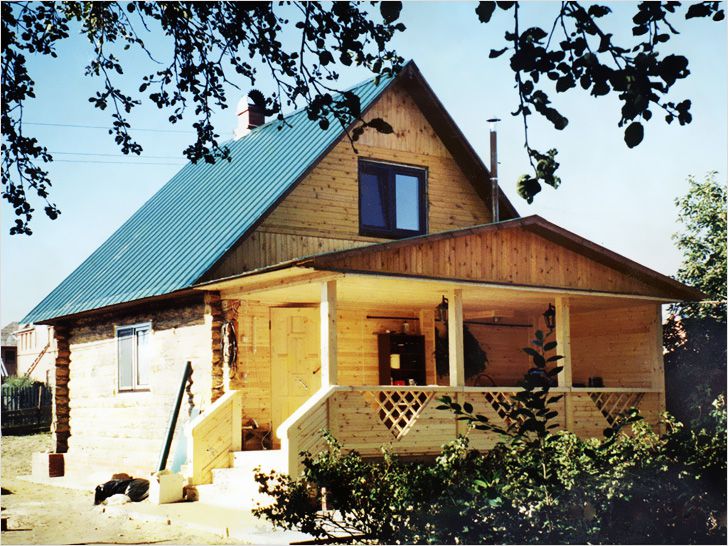
There are several positive aspects of the veranda attached to the bath:
- Significant increase in the area of \u200b\u200bthe bath.
- On the terrace, you can put a barbecue, barbecue or make a dining room.
- You can build a comfortable walk-through pool.
As you can see, the extension of the veranda to the bath is a profitable business. After all, this way you may have an additional area for relaxation. You can attach it yourself. First of all, you need to think about its size and shape. For example, it may be small, but complete with everything you need. As practice shows, a veranda with an area of \u200b\u200b8 m 2 is more than enough. If you want to make a larger veranda, then you can receive more guests. Accordingly, your construction costs will increase, but it's worth it. It should be borne in mind that after a while the nature of the use of the veranda may change slightly.
Types of outbuildings
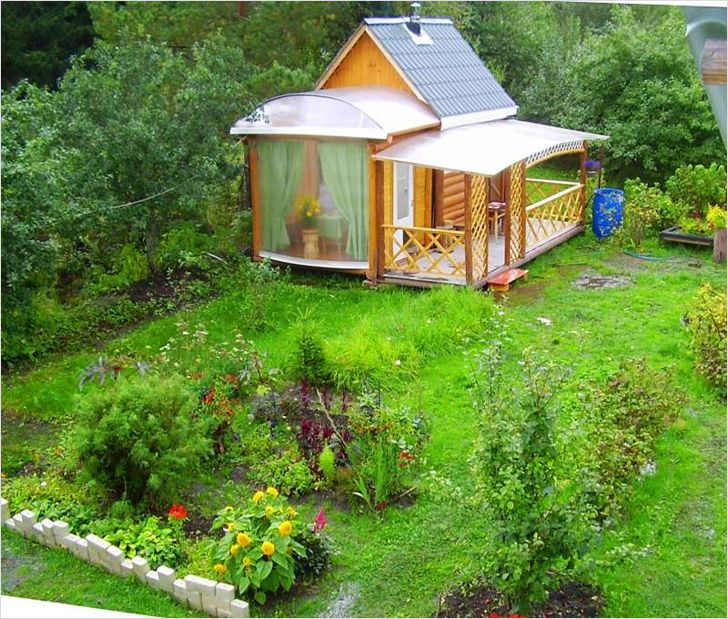
Today there is a wide variety of types of annexes to the bath. This means you don't have to build from a template.
Note! Complete harmony with the main building - the bathhouse - must be observed. As a result, everything should look as if it was originally one building.
The type of building directly depends on the purpose. For example, on the veranda when leaving the bath, you can organize a relaxation area, put upholstered furniture and a table / chair. Moreover, the choice of furniture should fully correspond to the overall style and interior. On the other hand, the veranda can be positioned so that it connects the bathhouse with a flowering garden. At the same time, gathering with friends, you can enjoy the beautiful nature. If the veranda is planned to be used in the cold season, then you will need to glaze it in order to maintain the required temperature. On such a veranda, you can organize a living corner, so it will be pleasant to spend time on it in winter.
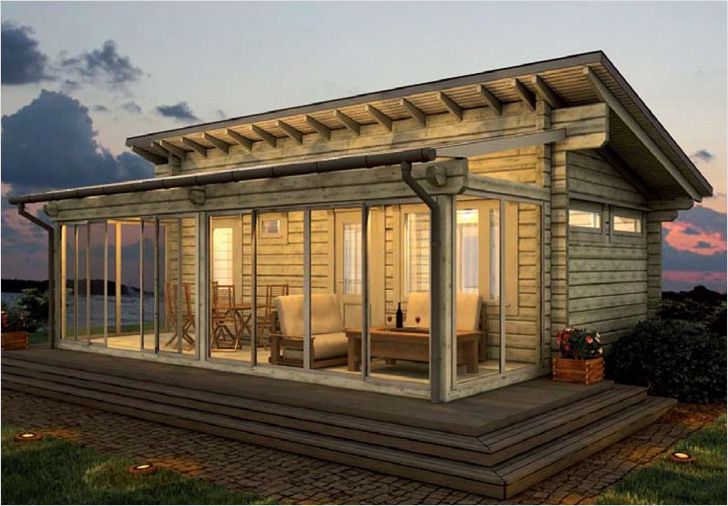
If the bathhouse and the veranda are planned to be used mainly in the summer season, then it is worth staying on the open veranda.
Note! Do not place it under the scorching rays of the sun. You can take advantage of the natural shade of the garden trees. As a result, it will be pleasant and comfortable to spend time with friends in it.
There is also the option of building a separate veranda. But this is another question, which is influenced by a large number of factors. In general, when you start designing a veranda, consider the following tips and tricks:
- Let the front door be on the south side. This will prevent snow from filling up the passage in harsh winters.
- If you have an artificial reservoir, then it is better to place the veranda closer to it. After taking a bath, you can plunge into cool water.
- The veranda can connect two buildings - a bathhouse and a house. But this is if the distance between them is no more than ten meters.
- A glazed veranda can be a great place to hang out in both summer and winter.
What to build from

The ideal material is wood. There is no point in talking about its advantages, everything is clear here. The tree has excellent technical characteristics and on top of that it is environmentally friendly. As a rule, it is customary to use a rounded coniferous log. The interior of the veranda is predominantly finished with linden, aspen or cedar wood. Attached veranda from a log will have several advantages:
- The natural structure of the log will add more beauty appearance the buildings.
- Wood permeates steam and air.
- Differs in long-term operation.
Such a veranda will be an excellent addition to an already built bathhouse. So, now let's take a step-by-step look at the process of building a veranda.
Connection of the foundation with the bath
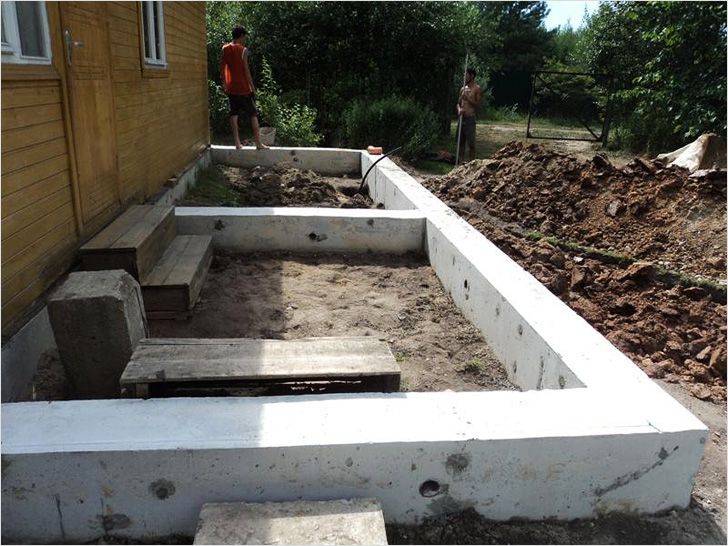
It is clear that it will not be possible to create a common foundation. So that after a while the walls do not move away from the base, it is necessary to think over everything to the smallest detail.
Note! The wall to which the veranda is attached must be strong.
The base of the attached veranda should have the same depth as the base of the bath. The height of the foundation must also match. To do this, dig a trench around the entire perimeter and make holes in the bath foundation. They are necessary for connecting the old and new foundations with reinforcement. At the next stage, formwork is built into the trench and a sand cushion up to 200 mm is made. After that, the installation of the reinforcement is carried out: it is inserted between the formwork panel, connecting to the base of the bath through the holes made.
Note! To make the connection reliable, you can use welding or special wire.
After complete manufacturing of the formwork and laying the reinforcement, concrete is poured into the trench.
After making the foundation, you can proceed to the following work.
Construction of an extension
The whole process is carried out in 4 stages.
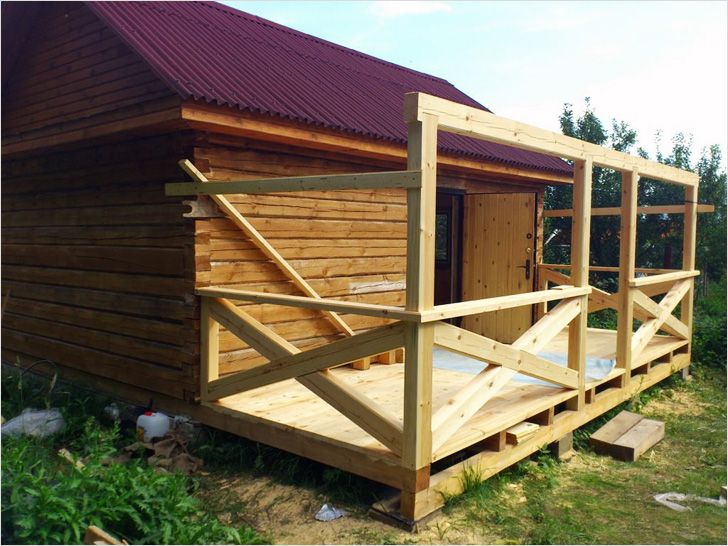
Walling. As mentioned above, here you can use a bar, logs. The main requirement is a combination with an already built sauna.
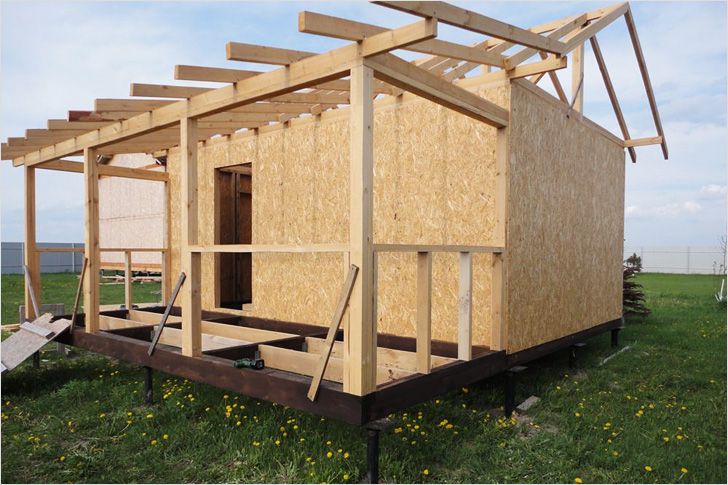
Roof installation. When choosing a material for the roof, you need to be guided by the material used for the roof of the bath, so here the choice will be obvious. If it's difficult to pick up, then he should at least closely resemble his future rooftop neighbor.

Installation of windows, doors. This is true if the veranda is closed.
Interior decoration.
If you connect your imagination, then a place for rest will appear on your personal plot, which will be an excellent addition to the dense steam in the bathhouse!
Video
This video, which shows the construction of the veranda in stages, will make the process of building an extension even more understandable:




